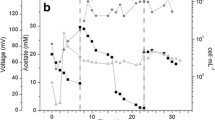Abstract
Power generation in microbial fuel cells (MFCs) is a function of the surface areas of the proton exchange membrane (PEM) and the cathode relative to that of the anode. To demonstrate this, the sizes of the anode and cathode were varied in two-chambered MFCs having PEMs with three different surface areas (A PEM=3.5, 6.2, or 30.6 cm2). For a fixed anode and cathode surface area (A An=A Cat=22.5 cm2), the power density normalized to the anode surface area increased with the PEM size in the order 45 mW/m2 (A PEM=3.5 cm2), 68 mW/m2 (A PEM=6.2 cm2), and 190 mW/m2 (A PEM=30.6 cm2). PEM surface area was shown to limit power output when the surface area of the PEM was smaller than that of the electrodes due to an increase in internal resistance. When the relative cross sections of the PEM, anode, and cathode were scaled according to 2A Cat=APEM=2A An, the maximum power densities of the three different MFCs, based on the surface area of the PEM (A PEM=3.5, 6.2, or 30.6 cm2), were the same (168±4.53 mW/m2). Increasing the ionic strength and using ferricyanide at the cathode also increased power output.








Similar content being viewed by others
References
Bond DR, Lovley DR (2003) Electricity production by Geobacter sulfurreducens attached to electrodes. Appl Environ Microbiol 69:1548–1555
Bond DR, Holmes DE, Tender LM, Lovley DR (2002) Electrode-reducing microorganisms that harvest energy from marine sediments. Science 295:483–485
Chang IS, Jang JK, Gil GC, Kim M, Kim HJ, Cho BW, Kim BH (2004) Continuous determination of biochemical oxygen demand using microbial fuel cell type biosensor. Biosens Bioelectron 19:607–613
Chaudhuri SK, Lovley DR (2003) Electricity generation by direct oxidation of glucose in mediatorless microbial fuel cells. Nat Biotechnol 21:1229–1232
Dentel SK, Strogen B, Sharma A, Chiu P (2004) Direct generation of electricity from sludges and other liquid wastes. Proceedings of the International Water Association Specialist Group on Sludge Management conference on resources from sludge: forging new frontiers, Singapore, 2–3 March 2004
Hinton A Jr (1999) Inhibition of the growth of Salmonella typhimurium ST-10 by propionic acid and chloride salts. Food Microbiol 16:401–407
Jang JK, Pham TH, Chang IS, Kang KH, Moon H, Cho KS, Kim BH (2004) Construction and operation of a novel mediator- and membrane-less microbial fuel cell. Process Biochem 39:1007–1012
Katz E (2005) http://chem.ch.huji.ac.il/∼eugeniik/alchemist_biofuel_cell.html
Kim HJ, Hyun MS, Chang IS, Kim BH (1999) A microbial fuel cell type lactate biosensor using a metal-reducing bacterium, Shewanella putrefaciens. J Microbiol Biotechnol 9:365–367
Kim HJ, Park HS, Hyun MS, Chang IS, Kim M, Kim BH (2002) A mediator-less microbial fuel cell using a metal reducing bacterium, Shewanella putrefacians. Enzyme Microb Technol 30:145–152
Liu H, Logan BE (2004) Electricity generation using an air cathode single chamber microbial fuel cell in the presence and absence of a proton exchange membrane. Environ Sci Technol 38:4040–4046
Liu H, Ramnarayanan R, Logan BE (2003) Production of electricity during wastewater treatment using a single chamber microbial fuel cell. Environ Sci Technol 38:2281–2285
Min B, Logan BE (2004) Continuous electricity generation from domestic wastewater and organic substrates in a flat plate microbial fuel cell. Environ Sci Technol 38:5809–5814
Oh S, Min B, Logan BE (2004) Cathode perfermance as a factor in electricity generation in microbial fuel cells. Environ Sci Technol 38:4900–4904
Park DH, Zeikus JG (2000) Electricity generation in microbial fuel cells using neutral red as an electronophore. Appl Environ Microbiol 66:1292–1297
Park DH, Zeikus JG (2003) Improved fuel cell and electrode designs for producing electricity from microbial degradation. Biotechnol Bioeng 81:348–355
Park HS, Kim BH, Kim HS, Kim HS, Kim GT, Kim M, Chang IS, Park YK, Chang HI (2001) A novel electro-chemically active and Fe(III)-reducing bacterium phylogenetically related to Clostridium butyricum isolated from a microbial fuel cell. Anaerobe 7:297–306
Rabaey K, Lissens G, Siciliano SD, Verstraete W (2003) A microbial fuel cell capable of converting glucose to electricity at high rate and efficiency. Biotechnol Lett 25:1531–1535
Rabaey K, Boon N, Siciliano SD, Verhaege M, Verstraete W (2004) Biofuel cells select for microbial consortia that self-mediate electron transfer. Appl Environ Microbiol 70:5373–5382
Reimers CE, Tender LM, Ferig S, Wang W (2001) Harvesting energy from marine sediment–water interface. Environ Sci Technol 35:192–195
Schröder U, Juliane N, Rfitz S (2003) A generation of microbial fuel cells with current outputs boosted by more than one order of magnitude. Angew Chem 42:2880–2883
Suzuki S, Karube I, Matsunaga T (1978) Application of a biochemical fuel cell to wastewaters. Biotechnol Bioeng Symp 8:501–511
Wilkinson S (2000) “Gastrobot”—benefits and challenges of microbial fuel cells in food powered robot applications. Auton Robots 9:99–111
Wingard LB Jr, Shaw CH, Castner JF (1982) Bioelectrochemical fuel-cells. Enzyme Microbiol Technol 4:137–142
Acknowledgements
The authors thank Shaoan Cheng and Tom Mallouk for advice on electrode potential measurements, and Hong Liu for help with the development of the power model. This research was supported by National Science Foundation Grants BES-0331824 and BES-0401885, USDA–DOE grant 68-3A75-3-150, the Penn State University Huck Life Sciences Institute, and the Stan and Flora Kappe Endowment.
Author information
Authors and Affiliations
Corresponding author
Rights and permissions
About this article
Cite this article
Oh, SE., Logan, B.E. Proton exchange membrane and electrode surface areas as factors that affect power generation in microbial fuel cells. Appl Microbiol Biotechnol 70, 162–169 (2006). https://doi.org/10.1007/s00253-005-0066-y
Received:
Revised:
Accepted:
Published:
Issue Date:
DOI: https://doi.org/10.1007/s00253-005-0066-y




